 |
|||||||||




 |
|||||||||




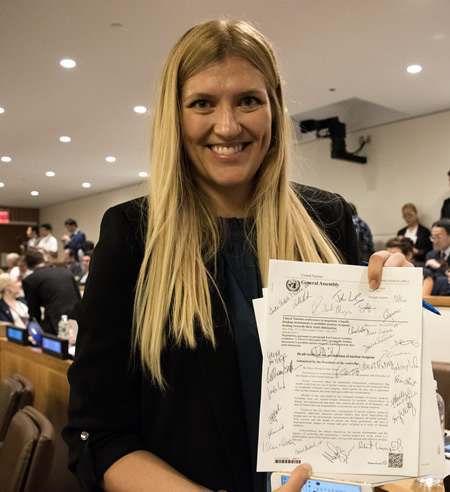
Photo: Beatrice Fihn, Executive Director, International Campaign to Abolish Nuclear Weapons (ICAN), with signed “Draft treaty on the prohibition of nuclear weapons” - 7th July 2017. Photographer: Clare Conboy. Image provided by & Copyright © ICAN.
Oslo, 6 October 2017 — The Norwegian Nobel Committee has decided to award the Nobel Peace Prize for 2017 to the International Campaign to Abolish Nuclear Weapons (ICAN). “The organization is receiving the award for its work to draw attention to the catastrophic humanitarian consequences of any use of nuclear weapons and for its ground-breaking efforts to achieve a treaty-based prohibition of such weapons,” the committee announced.
“We live in a world where the risk of nuclear weapons being used is greater than it has been for a long time. Some states are modernizing their nuclear arsenals, and there is a real danger that more countries will try to procure nuclear weapons, as exemplified by North Korea. Nuclear weapons pose a constant threat to humanity and all life on earth. Through binding international agreements, the international community has previously adopted prohibitions against land mines, cluster munitions and biological and chemical weapons. Nuclear weapons are even more destructive, but have not yet been made the object of a similar international legal prohibition.
“Through its work, ICAN has helped to fill this legal gap. An important argument in the rationale for prohibiting nuclear weapons is the unacceptable human suffering that a nuclear war will cause. ICAN is a coalition of non-governmental organizations from around 100 different countries around the globe. The coalition has been a driving force in prevailing upon the world’s nations to pledge to cooperate with all relevant stakeholders in efforts to stigmatise, prohibit and eliminate nuclear weapons. To date, 108 states have made such a commitment, known as the Humanitarian Pledge.
“Furthermore, ICAN has been the leading civil society actor in the endeavour to achieve a prohibition of nuclear weapons under international law. On 7 July 2017, 122 of the UN member states acceded to the Treaty on the Prohibition of Nuclear Weapons. As soon as the treaty has been ratified by 50 states, the ban on nuclear weapons will enter into force and will be binding under international law for all the countries that are party to the treaty.
“The Norwegian Nobel Committee is aware that an international legal prohibition will not in itself eliminate a single nuclear weapon, and that so far neither the states that already have nuclear weapons nor their closest allies support the nuclear weapon ban treaty. The Committee wishes to emphasize that the next steps towards attaining a world free of nuclear weapons must involve the nuclear-armed states. This year’s Peace Prize is therefore also a call upon these states to initiate serious negotiations with a view to the gradual, balanced and carefully monitored elimination of the almost 15,000 nuclear weapons in the world. Five of the states that currently have nuclear weapons - the USA, Russia, the United Kingdom, France and China - have already committed to this objective through their accession to the Treaty on the Non-Proliferation of Nuclear Weapons of 1970. The Non-Proliferation Treaty will remain the primary international legal instrument for promoting nuclear disarmament and preventing the further spread of such weapons.
“It is now 71 years since the UN General Assembly, in its very first resolution, advocated the importance of nuclear disarmament and a nuclear weapon-free world. With this year’s award, the Norwegian Nobel Committee wishes to pay tribute to ICAN for giving new momentum to the efforts to achieve this goal.
“It is the firm conviction of the Norwegian Nobel Committee that ICAN, more than anyone else, has in the past year given the efforts to achieve a world without nuclear weapons a new direction and new vigour,” the Norwegian Nobel Committee stated in its announcement.
|GlobalGiants.Com|
Edited & Posted by the Editor | 8:31 AM | View the original post
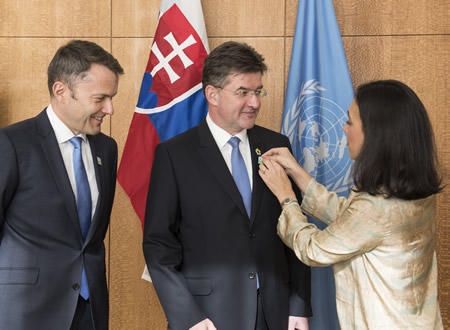
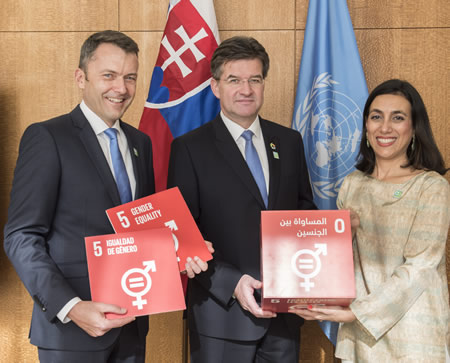
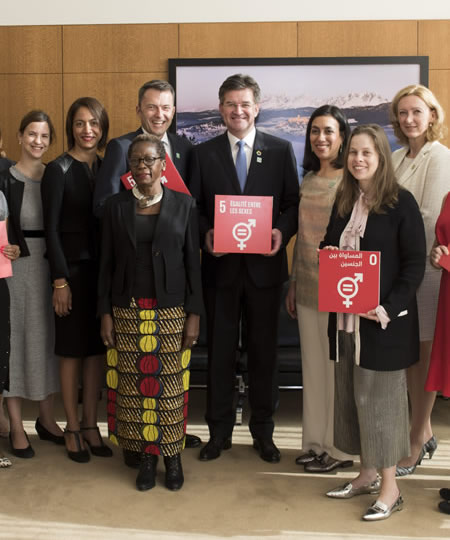
Photos: Miroslav LajÄák, President of the seventy-second session of the UN General Assembly, joined the growing list of International Gender Champions (IGC) at a special ceremony held in his office. IGC is a network of senior leaders of the UN Secretariat, funds, programmes and agencies, Member States, local governments, private sector leaders and civil society striving to achieve gender equality by breaking down gender barriers in a very practical way.
Mr. LajÄák (centre) on the occasion in his office with Laura Elena Flores Herrera (right), Permanent Representative of Panama to the UN; and Jürg Lauber, Permanent Representative of Switzerland, both of whom are also Champions. 29 September 2017. United Nations, New York. UN Photos/Kim Haughton.
|GlobalGiants.Com|
Edited & Posted by the Editor | 5:25 AM | View the original post
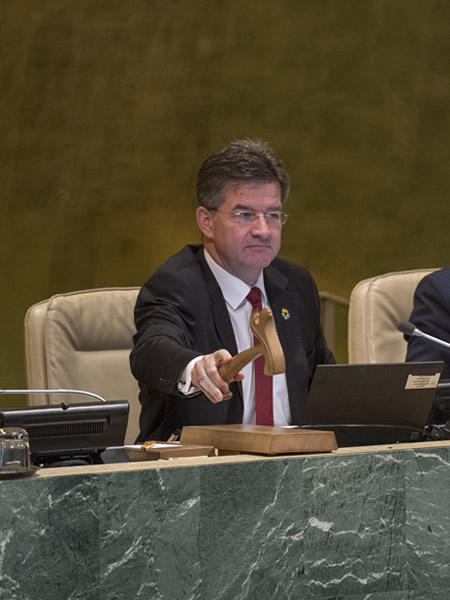
Photo: Miroslav LajÄák, President of the seventy-second session of the UN General Assembly, chairs the Assembly’s high-level meeting to appraise progress achieved in the implementation of the United Nations Global Plan of Action to Combat Trafficking in Persons. 27 September 2017. United Nations, New York. UN Photo/Cia Pak.
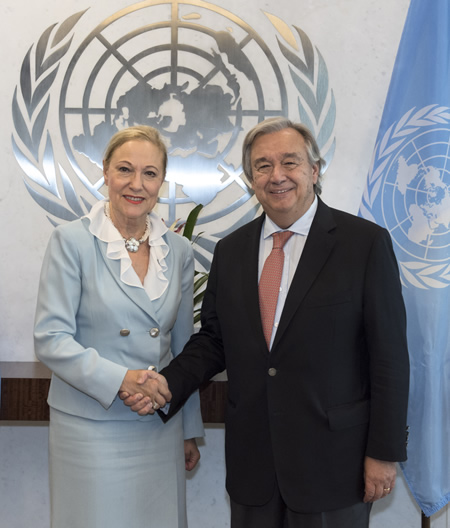
Photo: UN Secretary-General António Guterres (right) meets with Benita Ferrero-Waldner, Chair of the Board of the United Nations Voluntary Trust Fund for Victims of Trafficking in Persons. 27 September 2017. United Nations, New York. UN Photo/Kim Haughton.
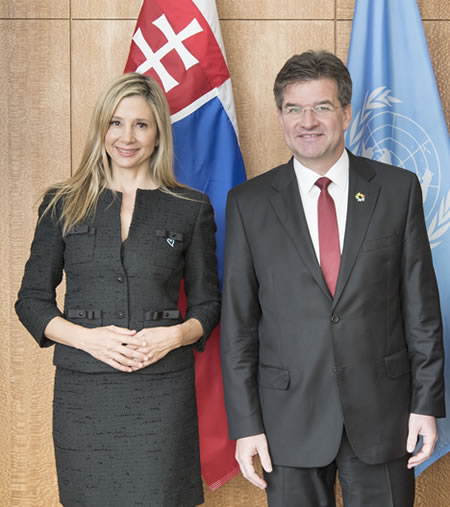
Photo: Miroslav LajÄák, President of the seventy-second session of the UN General Assembly, meets with Mira Sorvino (left), UNODC (UN Office on Drugs and Crime) Goodwill Ambassador for Global Fight against Human Trafficking. 27 September 2017. United Nations, New York. UN Photo/Mark Garten.
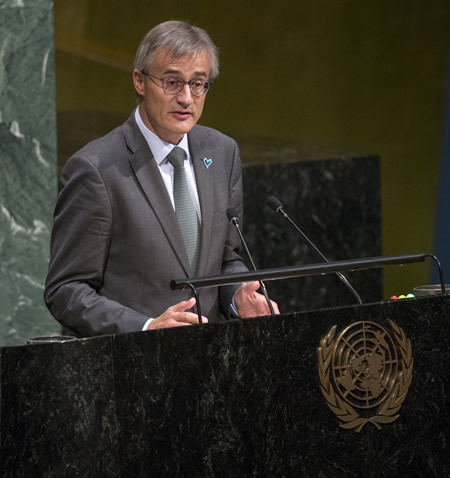
Photo: Félix Braz, Minister of Justice of Luxembourg, addresses the UN General Assembly high-level meeting to appraise progress achieved in the implementation of the United Nations Global Plan of Action to Combat Trafficking in Persons. 27 September 2017. United Nations, New York. UN Photo/Cia Pak.
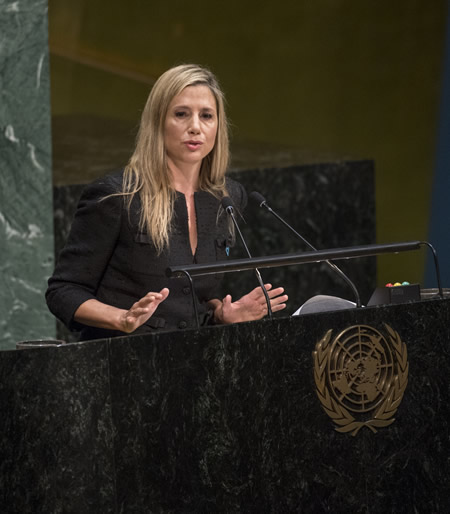
Photo: Mira Sorvino, Academy Award-winning actress and Goodwill Ambassador for the United Nations Office on Drugs and Crime (UNODC), addresses the high-level meeting of the UN General Assembly on the appraisal of the UN Global Plan of Action to Combat Trafficking in Persons. 27 September 2017. United Nations, New York. UN Photo/Cia Pak.
United Nations, 27 September 2017 - With tens of millions of human trafficking victims worldwide, “now is the time to stand together and stamp out this abominable practice,” Secretary-General António Guterres told a high-level meeting at which Member States adopted a political Declaration reaffirming their commitment to implement a United Nations action plan to end the scourge.
“Human trafficking is all around us, in all regions of the world,” said Mr. Guterres, referring to such practices as “Forced Labour” and “Sexual Servitude” in different forms and manifestations.
In the Declaration, adopted without a vote, UN Member States demonstrated their strong political will to take decisive concerted action to end the heinous crime.
“As millions of children, women and men spill out of their countries towards safety, they find themselves at the mercy of merciless people,” Mr. Guterres said.
These criminal networks are global, well-organized, technologically savvy, and highly proficient in taking advantage of gaps in governance and weaknesses in institutions, he added.
Fighting human trafficking requires greater use of relevant instruments, including the UN conventions against transnational organized crime and against corruption, he said.
Also addressing the meeting, Yuri Fedotov, Executive Director of the UN Office on Drugs and Crime (UNODC), said “this appraisal and the adoption of the political Declaration can help us take this commitment forward and sharpen responses to an odious crime that continues to exploit and victimize the most vulnerable, in all parts of the world.”
To build a robust evidence base, UNODC is currently working with the academic community to develop innovative methodologies to measure the size and scope of the trafficking problem, he added.
General Assembly President Miroslav LajÄák also addressed the meeting, as did Ms. Mira Sorvino, UNODC Goodwill Ambassador for the global fight against human trafficking and Grizelda Grootboom, a civil society representative and victim of human trafficking.
The high-level meeting was addressed by the representatives of Jamaica, Sweden, Italy, Nigeria, Botswana, Zambia, United States, Cuba, Morocco, Brazil, Denmark, Slovenia, Myanmar, Austria, Portugal, Mexico, Philippines, Peru, Paraguay, India, Cameroon, Bahamas, Republic of Korea, Germany, Pakistan, Guatemala, Libya, Argentina, Colombia, Kenya, Canada, Azerbaijan, Latvia, Finland, Liechtenstein, Japan, Cabo Verde, Chile, Costa Rica, Ecuador, Mongolia, Cyprus, Bulgaria, Saudi Arabia, United Republic of Tanzania, Uruguay, Switzerland, Hungary, Ireland, Georgia, Kazakhstan, Honduras, Viet Nam, El Salvador, Bahrain, Maldives, Iceland, Burkina Faso, Rwanda, Bangladesh, China, Iraq, Jordan, Kuwait, Saint Vincent and Grenadines and Spain.
The speakers called for tailored, effective, multilateral efforts to protect the victims and prosecute the perpetrators.
|GlobalGiants.Com|
Edited & Posted by the Editor | 4:46 PM | View the original post
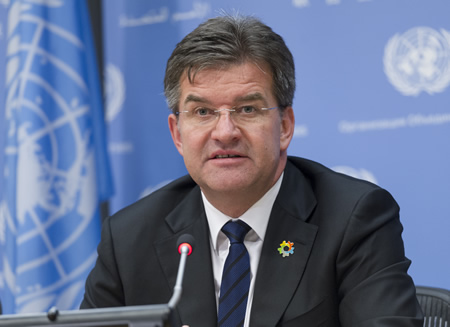
Photo: Miroslav LajÄák (left), President of the seventy-second session of the General Assembly, briefs journalists on the outcomes and achievements of the Assembly’s annual general debate, which took place from 19 to 25 September. 26 September 2017. United Nations, New York. UN Photo/Rick Bajornas.
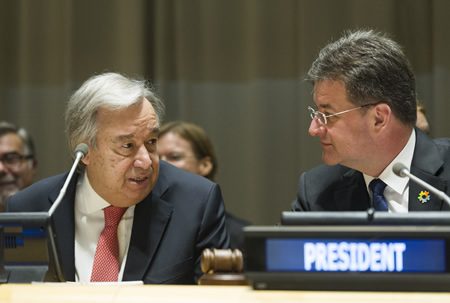
Photo: Miroslav LajÄák (right), President of the seventy-second session of the General Assembly, opens the high-level plenary meeting commemorating and promoting the International Day for the Total Elimination of Nuclear Weapons. Secretary-General António Guterres is on the left. 26 September 2017. United Nations, New York. UN Photo/Rick Bajornas.
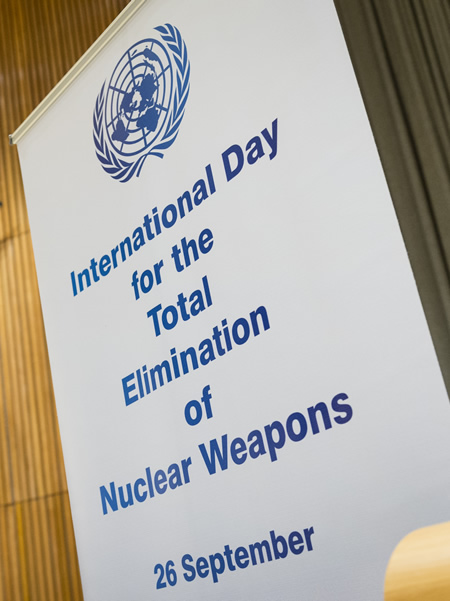
Photo: The UN General Assembly convenes a high-level meeting to commemorate and promote the International Day for the Total Elimination of Nuclear Weapons (26 September). 26 September 2017. United Nations, New York. UN Photo/Rick Bajornas.
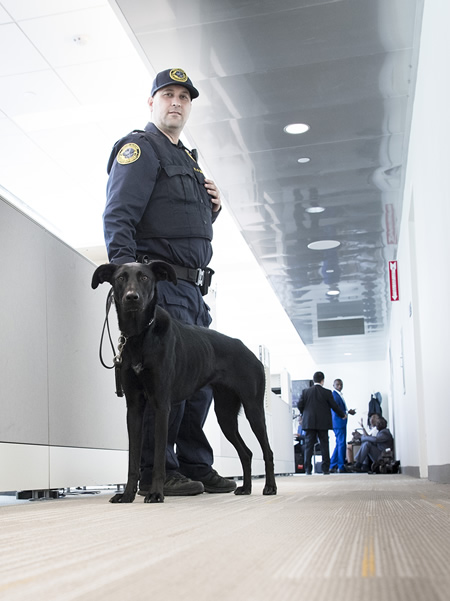
Photo: Mia, a member of the UN Security and Safety K-9 (Canine) Unit for explosives detection, at work with her handler in the Secretariat Building of UN headquarters. UN Photo/Mark Garten. 22 September 2017. United Nations, New York.
The United Nations General Assembly has wrapped up its 72nd annual general debate with its President underscoring prevention of conflicts before they break out, support for UN peacekeeping, sustainable development, and respect for human rights and gender equality among the major priorities raised by the 196 Heads of State, Government and delegations.
“You reaffirmed your commitment to the UN. And to each other. You said we are stronger together, in a system based on dialogue and multilateralism,” President Miroslav LajÄák declared, summing up the main thrust of the debate whose theme was ‘Focusing on People - Striving for Peace and a Decent Life for All on a Sustainable Planet.’
During six days of debate, several representatives focused on the global economic and political systems — including within the United Nations — as unfair and unrepresentative, with many stressing that the Organization’s reform must include a reorientation of the Security Council’s membership.
|GlobalGiants.Com|

“Incidents should not govern policy; but, policy incidents.”
— Napoleon Bonaparte.

“The question upon which the whole future peace and policy of the world depends is this: Is the present war a struggle for a just and secure peace, or only for a new balance of power? If it be only a struggle for a new balance of power, who will guarantee, who can guarantee, the stable equilibrium of the new arrangement? … There must be, not a balance of power, but a community of power; not organized rivalries, but an organized common peace.”
— Woodrow Wilson, President of the United States from 1913 to 1921.
Edited & Posted by the Editor | 7:21 AM | View the original post
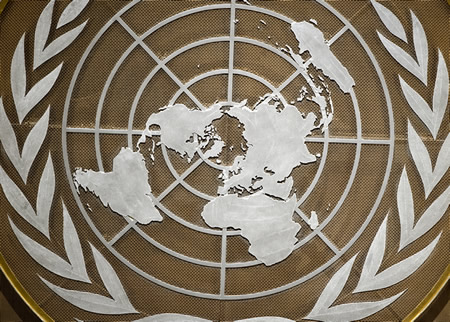
Photo: The logo of the United Nations in the General Assembly Hall, as the Assembly opens the general debate of its seventy-second regular session. 19 September 2017. United Nations, New York. UN Photo/Cia Pak.
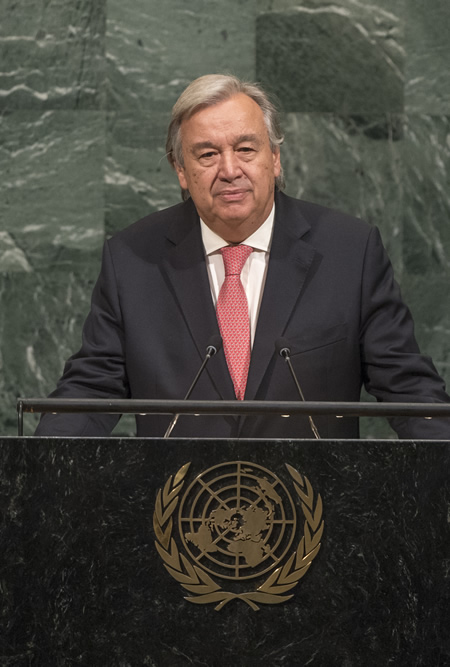
Photo: UN Secretary-General António Guterres presents his annual report on the work of the Organization at the opening of the General Assembly’s seventy-second general debate. 19 September 2017. United Nations, New York. UN Photo/Cia Pak.
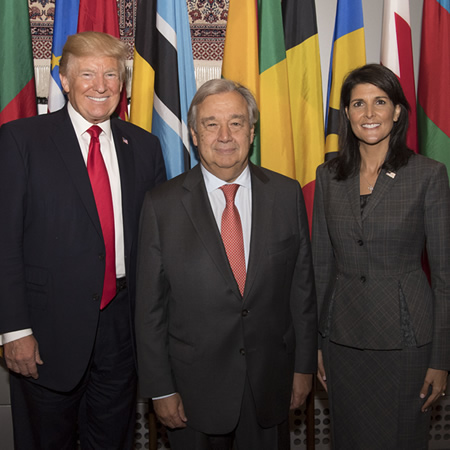
Photo: UN Secretary-General António Guterres (centre) meets with United States President Donald Trump (left). Also pictured, Nikki Haley, United States Permanent Representative to the UN. 18 September 2017. United Nations, New York. UN Photo/Eskinder Debebe.
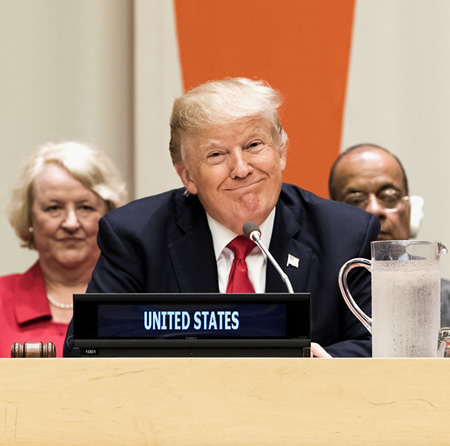
Photo: United States President Donald Trump during the high-level meeting on reform of the United Nations convened by the United States. 18 September 2017. United Nations, New York. UN Photo/Mark Garten.
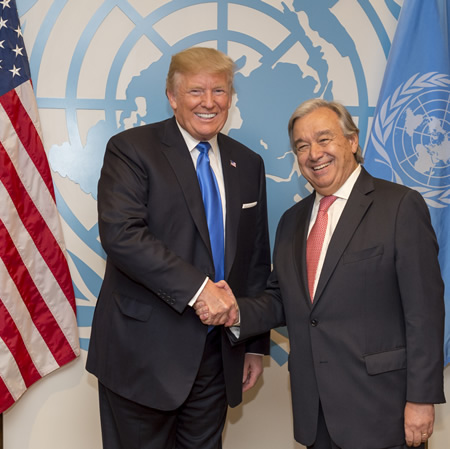
Photo: UN Secretary-General António Guterres (right) meets with United States President Donald Trump. 19 September 2017. UN Photo/Rick Bajornas.
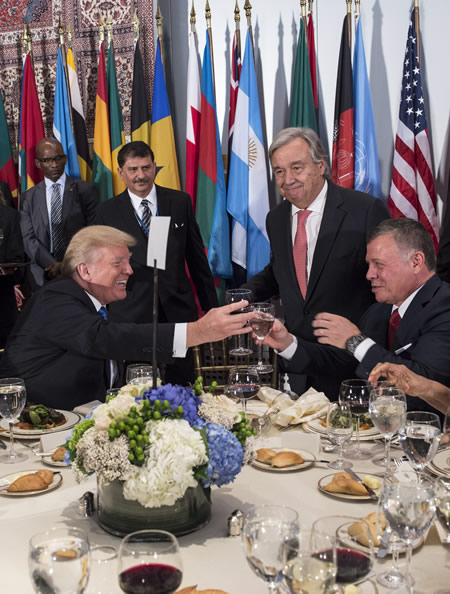
Photo: UN Secretary-General António Guterres hosted a luncheon in honour of the heads of delegations attending the general debate of the General Assembly’s seventy-second session.
United States President Donald Trump (left) shares a toast with King Abdullah II Bin Al Hussein of the Hashemite Kingdom of Jordan, as the Secretary-General (centre) looks on. 19 September 2017. United Nations, New York. UN Photo/Kim Haughton.
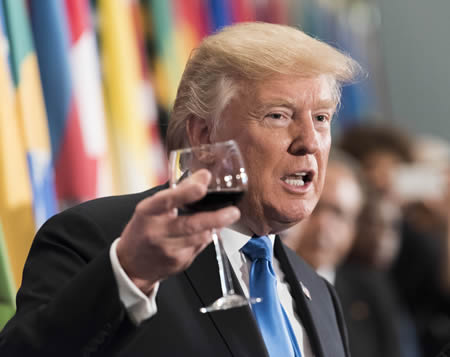
Photo: UN Secretary-General António Guterres hosted a luncheon in honour of the heads of delegations attending the general debate of the General Assembly’s seventy-second session. United States President Donald Trump offers a toast at the luncheon. 19 September 2017. United Nations, New York. UN Photo/Mark Garten.
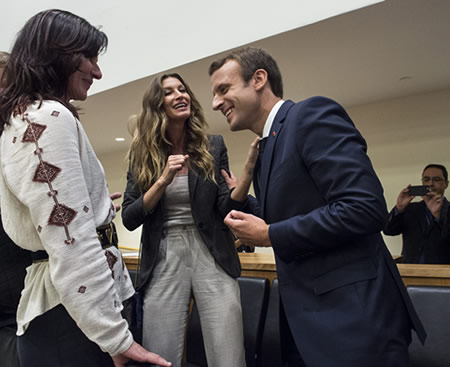
Photo: Emmanuel Macron (right), President of France, at the Summit to Launch the Global Pact for the Environment, which took place on the margins of the annual general debate of the General Assembly. 19 September 2017. United Nations, New York. UN Photo/Kim Haughton.
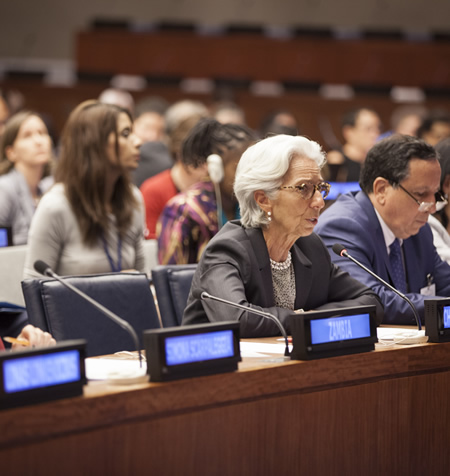
Photo: Christine Lagarde, Managing Director of the International Monetary Fund (IMF), addresses an event entitled, “Leave No One Behind: Actions and Commitments for Women’s Economic Empowerment”, which took place on the margins of the General Assembly’s annual general debate. 19 September 2017. United Nations, New York. UN Photo/Ariana Lindquist.
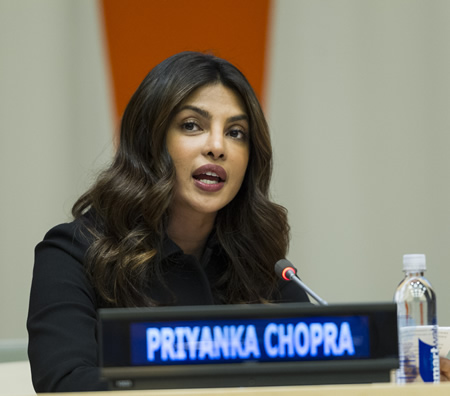
Photo: Priyanka Chopra, UNICEF Goodwill Ambassador, makes remarks during an event on “Financing the Future: Education 2030”. 20 September 2017. United Nations, New York. UN Photo/Rick Bajornas.
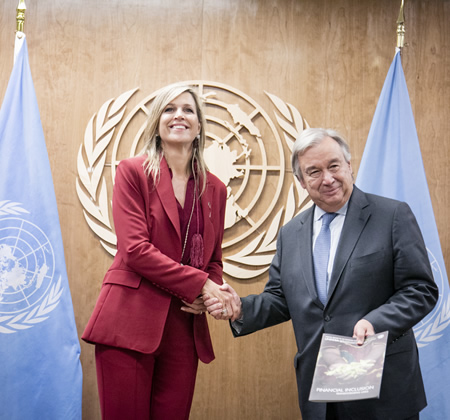
Photo: UN Secretary-General, António Guterres (right), meets with Queen Maxima of the Netherlands, his Special Advocate for Inclusive Finance for Development. 20 September 2017. United Nations, New York. UN Photo/Ariana Lindquist.
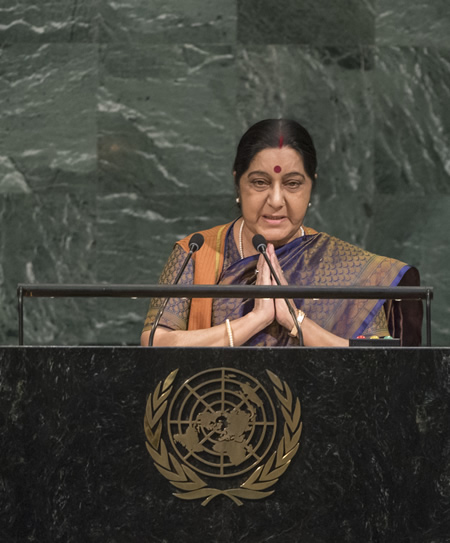
Photo: Sushma Swaraj, Minister for External Affairs of India, addresses the general debate of the General Assembly’s seventy-second session. 23 September 2017. United Nations, New York. UN Photo/Cia Pak.
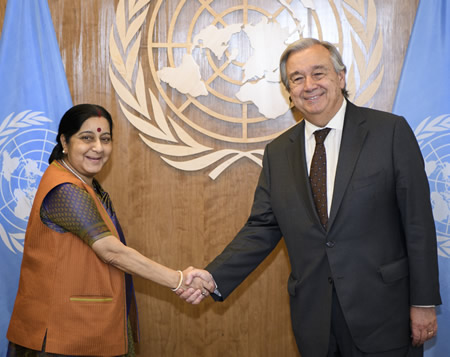
Photo: UN Secretary-General, António Guterres (right), meets with Sushma Swaraj, Minister for External Affairs of India. 23 September 2017. United Nations, New York. UN Photo/Manuel Elias.
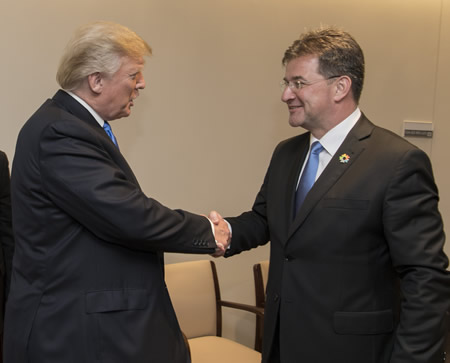
Photo: Miroslav LajÄák (right), President of the seventy-second session of the General Assembly, meets with Donald J. Trump, President of the United States of America. 19 September 2017. United Nations, New York. UN Photo/Mark Garten.
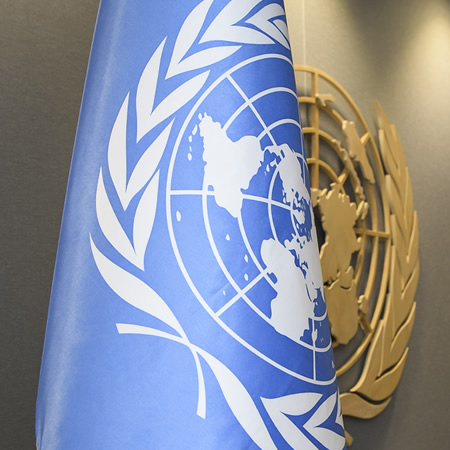
Photo: Scene at a meeting room during the general debate of the General Assembly’s seventy-second session. UN Headquarters. UN Photo/Manuel Elias. 17 September 2017. United Nations, New York.
|GlobalGiants.Com|
Edited & Posted by the Editor | 2:45 PM | View the original post
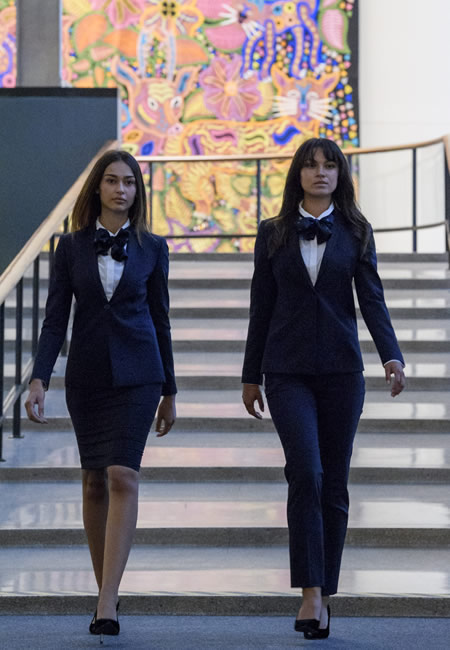

Photos: A new wardrobe for United Nations tour guides created by fashion designer Elie Tahari was launched at a special event held in the UN General Assembly Building. 14 September 2017. United Nations, New York. UN Photos/Manuel Elias.
|GlobalGiants.Com|
Edited & Posted by the Editor | 3:35 PM | View the original post
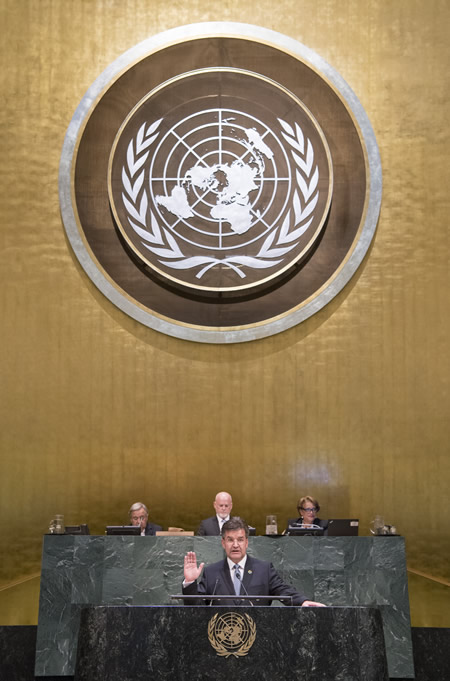
Photo: Miroslav LajÄák is sworn in as President of the seventy-second session of the UN General Assembly. 11 September 2017. United Nations, New York. UN Photo/Eskinder Debebe.
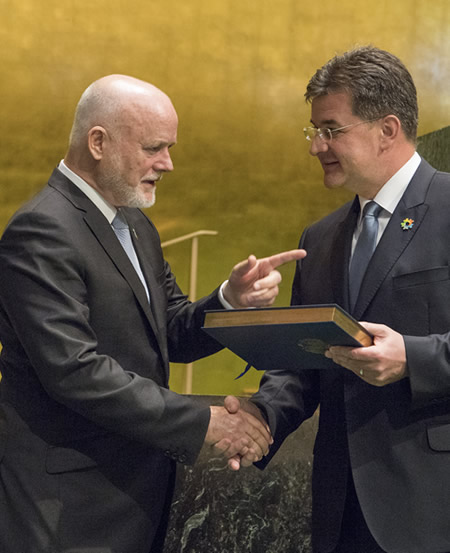
Photo: Miroslav LajÄák, President-elect of the seventy-second session of the UN General Assembly, took the oath of office during the last meeting of the Assembly’s seventy-first session.
Mr. LajÄák (right) receives from Peter Thomson, President of the Assembly’s seventy-first session, the copy of the UN Charter on which Mr. LajÄák took the oath.
11 September 2017. United Nations, New York. UN Photo/Eskinder Debebe.
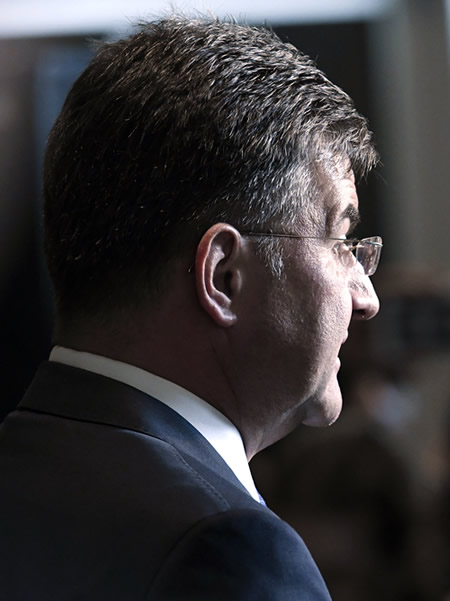
Photo: Miroslav LajÄák, President of the seventy-second session of the UN General Assembly, speaks to journalists on his priorities, following the opening meeting of the session. 12 September 2017. United Nations, New York. UN Photo/Evan Schneider.
|GlobalGiants.Com|
Edited & Posted by the Editor | 7:00 AM | View the original post
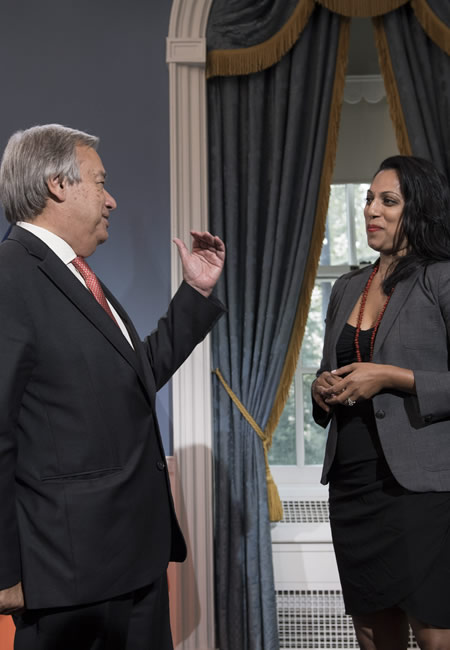
Photo: UN Secretary-General António Guterres (left) speaks with Penny Abeywardena (right), New York City’s Commissioner for International Affairs, prior to a meeting with Mayor Bill de Blasio. 24 August 2017. United Nations, New York. UN Photo/Mark Garten.
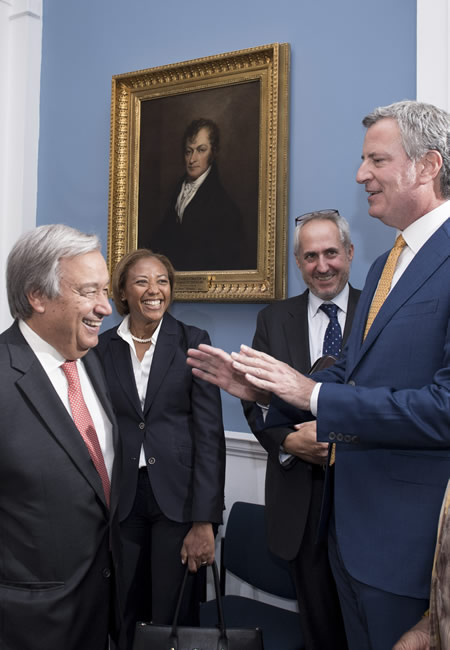
Photo: UN Secretary-General António Guterres (left) meets with New York City Mayor, Bill de Blasio (right). 24 August 2017. United Nations, New York. UN Photo/Mark Garten.
|GlobalGiants.Com|
Edited & Posted by the Editor | 11:48 AM | View the original post
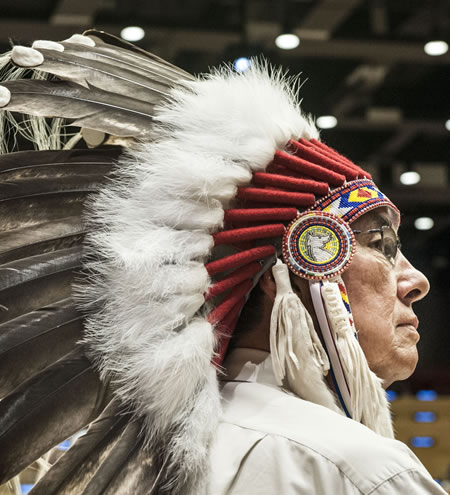
Photo: Grand Chief Wilton Littlechild, a Cree Chief from Canada, makes a ceremonial call to order prior to an event held on the occasion of the International Day of the World’s Indigenous Peoples and the tenth anniversary of the United Nations Declaration on the Rights of Indigenous Peoples (UNDRIP), under the theme “A Decade in Review: Achieving the Rights of Indigenous Peoples”. 09 August 2017. United Nations, New York. UN Photo/Kim Haughton.
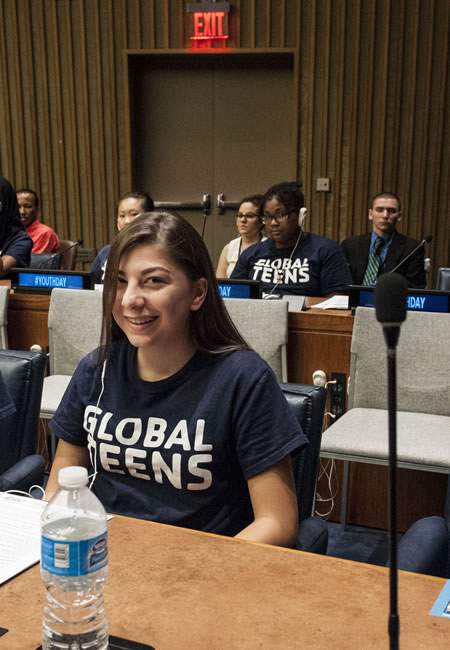
Photo: A participant at an event entitled “Youth Building Peace”, commemorating International Youth Day (12 August). The event was hosted by the Division for Social Policy and Development (DSPD) of the UN Department of Economic and Social Affairs (DESA), in collaboration with the Working Group on Youth and Peacebuilding of the Inter-agency Network on Youth Development. 11 August 2017. United Nations, New York. UN Photo/Kim Haughton.
|GlobalGiants.Com|
Edited & Posted by the Editor | 5:28 AM | View the original post

Photo: Temple Architecture, Historic City of Ahmedabad, India.
Krakow, Poland, 08 July 2017 — UNESCO’s World Heritage Committee has inscribed three cultural sites in Cambodia, China and India.
The sites added, in order of inscription are:
• Temple Zone of Sambor Prei Kuk, Archaeological Site of Ancient Ishanapura (Cambodia):
The archaeological site of Sambor Prei Kuk, “the temple in the richness of the forest” in the Khmer language, has been identified as Ishanapura, the capital of the Chenla Empire that flourished in the late 6th and early 7th centuries CE. The vestiges of the city cover an area of 25 square kilometres and include a walled city centre as well as numerous temples, ten of which are octagonal, unique specimens of their genre in southeast Asia. Decorated sandstone elements in the site are characteristic of the pre-Angkor decorative idiom, known as the Sambor Prei Kuk Style. Some of these elements, including lintels, pediments and colonnades, are true masterpieces. The art and architecture developed here became models for other parts of the region and lay the ground for the unique Khmer style of the Angkor period.
• Kulangsu: A historic international settlement (China):
Kulangsu is a tiny island located on the estuary of the Chiu-lung River, facing the city of Xiamen. With the opening of a commercial port at Xiamen in 1843, and the establishment of the island as an international settlement in 1903, this island off the southern coast of the Chinese empire suddenly became an important window for Sino-foreign exchanges. Kulangsu is an exceptional example of the cultural fusion that emerged from these exchanges, which remain legible in its urban fabric. There is a mixture of different architectural styles including Traditional Southern Fujian Style, Western Classical Revival Style and Veranda Colonial Style. The most exceptional testimony of the fusion of various stylistic influences is a new architectural movement, the Amoy Deco Style, which is a synthesis of the Modernist style of the early 20th century and Art Deco.
• Historic City of Ahmadabad (India):
The walled city of Ahmadabad, founded by Sultan Ahmad Shah in the 15th century, on the eastern bank of the Sabarmati river, presents a rich architectural heritage from the sultanate period, notably the Bhadra citadel, the walls and gates of the Fort city and numerous mosques and tombs as well as important Hindu and Jain temples of later periods. The urban fabric is made up of densely-packed traditional houses (pols) in gated traditional streets (puras) with characteristic features such as bird feeders, public wells and religious institutions. The city continued to flourish as the capital of the State of Gujarat for six centuries, up to the present.
The 41st session of the UNESCO World Heritage Committee (9-12 July), chaired by Jacek Purchla, founder and director of the International Cultural Centre in Krakow, is inscribing new sites on the World Heritage List.
|GlobalGiants.Com|
Edited & Posted by the Editor | 4:44 PM | View the original post
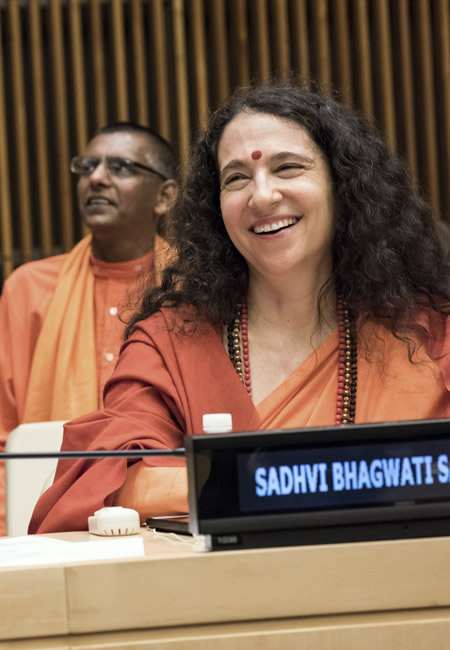
Photo: A scene from an event entitled “Conversation on Yoga for Health”, on the occasion of the International Day of Yoga. The event was co-organized by the Permanent Mission of India, the World Health Organization (WHO), and the UN Department of Public Information. Nata Menabde, Executive Director of the WHO Office at the UN, offered opening remarks. 21 June 2017. United Nations, New York. UN Photo/Kim Haughton.
|GlobalGiants.Com|
Edited & Posted by the Editor | 9:00 PM | View the original post
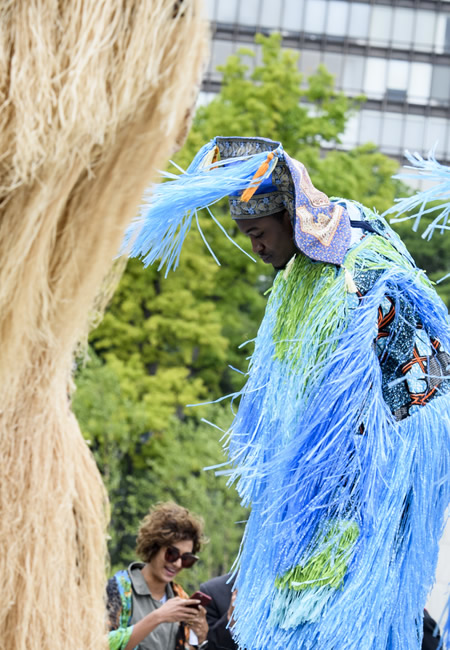
Photo: Stilt dancers, musicians, and ritual processions came together at the UN Visitors’ Plaza in a new performance piece entitled “Ocean Calling” to mark World Oceans Day (June 8). The marine-centric work was created by artist Laura Anderson Barbata in collaboration with choreographer Chris Walker, The Brooklyn Jumbies, choreographer and dancer Mei Yamanaka, and Jarana Beat. The event was organized by the Office of the President of the General Assembly with TBA21-Academy. 08 June 2017. United Nations, New York. UN Photo/Manuel Elias.
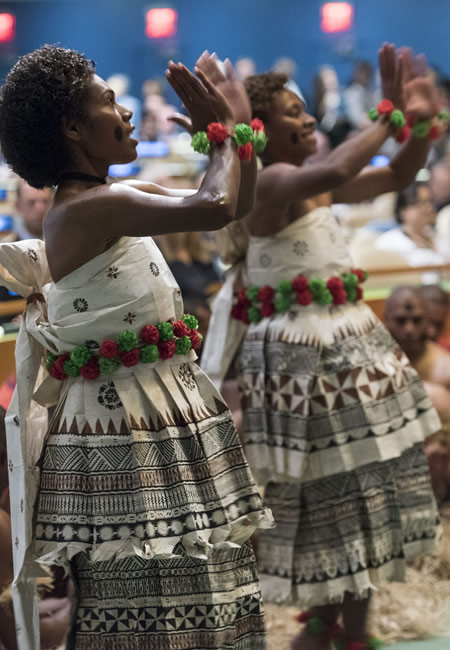
Photo: The Ocean Conference opens with a Fijian traditional welcome ceremony. The UN Ocean Conference took place at UN headquarters in New York from 5 to 9 June 2017, coinciding with World Oceans Day (8 June). Co-chaired by Fiji and Sweden, the Conference aimed to support the implementation of Sustainable Development Goal 14: Conserve and sustainably use the oceans, seas and marine resources for sustainable development. 05 June 2017. United Nations, New York. UN Photo/Mark Garten.
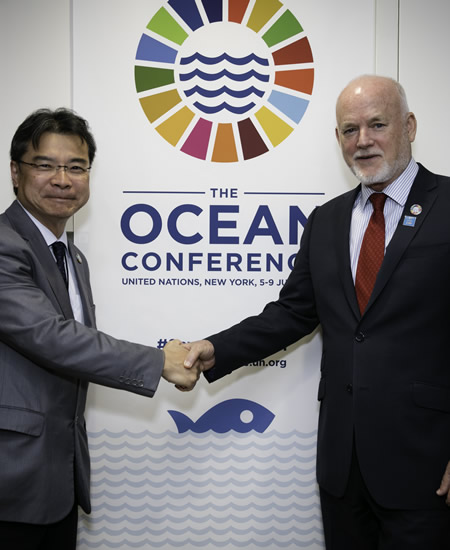
Photo: Peter Thomson (right), President of the seventy-first session of the UN General Assembly, meets with Yoshioka Tatsuya, Co-founder and Director of Peace Boat, on the margins of the 5-9 June Ocean Conference. 07 June 2017. United Nations, New York. UN Photo/Ariana Lindquist.
|GlobalGiants.Com|
Edited & Posted by the Editor | 12:57 PM | View the original post
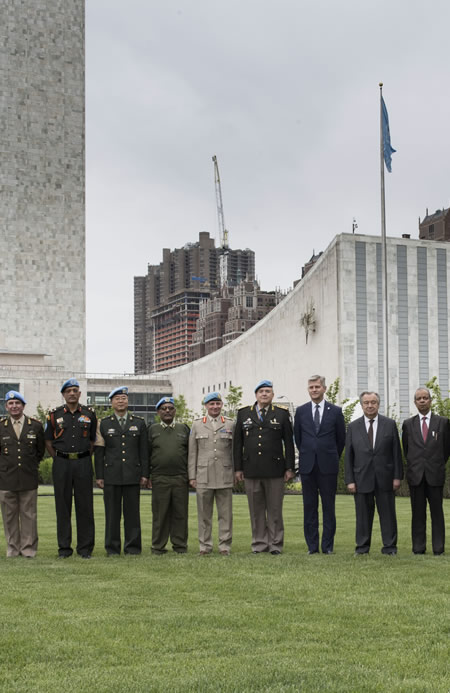
Photo: UN Secretary-General Antonio Guterres, Jean-Pierre Lacroix (left of Mr. Guterres), Under-Secretary-General for Peacekeeping Operations; and Atul Khare (right of Mr. Guterres), Under-Secretary-General for Field Support; pose for a group photo with Force Commanders of the Department of Peacekeeping Operations. 24 May 2017. United Nations, New York. UN Photo/Mark Garten.
|GlobalGiants.Com|
Edited & Posted by the Editor | 12:50 AM | View the original post
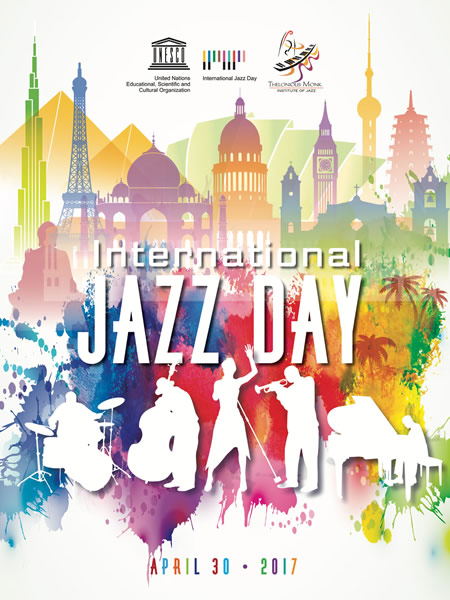

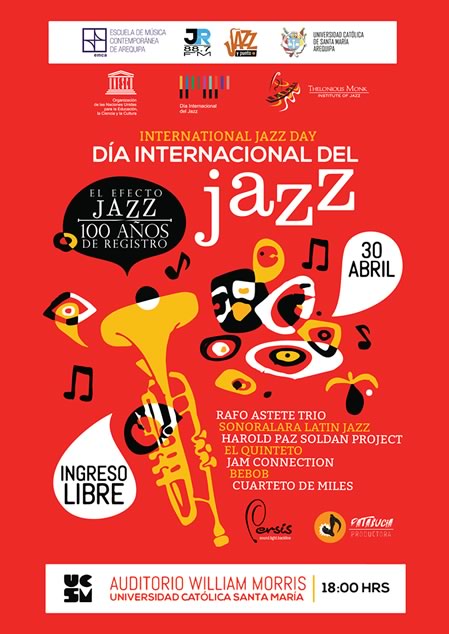
Havana, Cuba - Following thousands of events taking place in over 190 countries, International Jazz Day 2017 culminated in a concert streamed worldwide from Havana’s historic Gran Teatro de La Habana Alicia Alonso. As the International Jazz Day 2017 Global Host City, the musically vibrant city of Havana also presented a wide range of concerts and education programs.
Established by the United Nations Educational, Scientific and Cultural Organization (UNESCO) in coordination with the Thelonious Monk Institute of Jazz, International Jazz Day is recognized on the official calendars of UNESCO and the United Nations. Each year, on April 30, International Jazz Day highlights the role of jazz in promoting freedom, creativity and intercultural dialogue, and uniting people from all corners of the globe. Toyota served as Lead Partner of International Jazz Day 2017.
The Global Concert included an all-star group of musicians from Cuba and around the world performing “Cuba Bop” and “Manteca”. Cuban trumpet virtuoso Julio Padron played Freddie Hubbard’s composition, while the acclaimed vocalist Cassandra Wilson performed her composition “You Move Me”.
|GlobalGiants.Com|
Edited & Posted by the Editor | 5:12 PM | View the original post
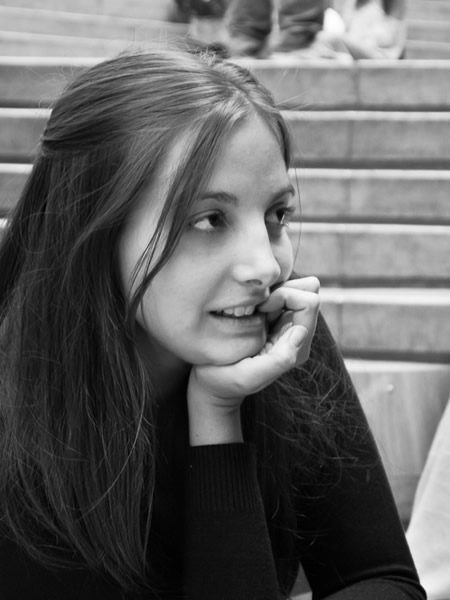
Photo: A College Student. Image Credit & Photographer: Francisco Osorio.
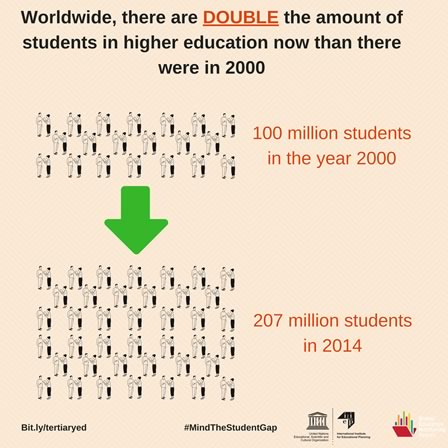
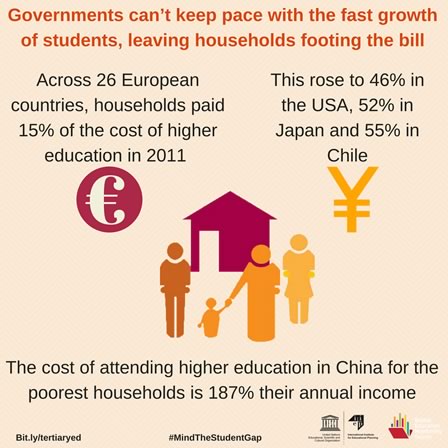
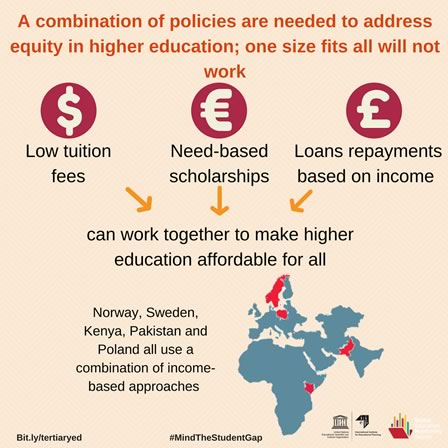
A new policy paper from the Global Education Monitoring (GEM) Report and the International Institute for Educational Planning (IIEP) at UNESCO shows that the number of university level students doubled to 207 million between 2000 and 2014. Governments are struggling to keep pace with rapidly rising demand and large disparities in access, with a large cost of higher education often falling to families, many of whom cannot afford it.
The new paper, Six ways to ensure higher education leaves no one behind, sets out a series of measures to make higher education more equitable and affordable, including to ensure that student loan repayments do not exceed 15% of a student’s monthly income. Anything more threatens to leave the disadvantaged behind.
“By creating and transmitting vital knowledge, skills and core values, higher education is a cornerstone for achieving the Sustainable Development Goals,” said Irina Bokova, Director-General of UNESCO. “Demand for higher education is going to continue rising. Governments must respond by introducing a range of new policies that will ensure expansion doesn’t leave the marginalised behind, and that access is based on merit, not privilege.”
Analyzing global trends, the paper also shows that only 1% of the poorest students have spent more than four years in higher education, compared to 20% of the richest.
In South Africa, around one-sixth of blacks and coloreds attended higher education in 2013, compared to over 50% of whites. Similarly, in Mexico, less than 1% of the indigenous population attend higher education. In China, youth from rural areas are seven times less likely to attend university than students from urban areas.
Access to higher education has expanded most rapidly in wealthier countries: Only 8% of young adults are enrolled on average in the poorest countries, compared to 74% in the richest countries. The greatest gender disparities are found among the poorest countries as well. Women made up only 30% of bachelor students in low-income countries in 2014.
“In certain countries with deeply rooted social inequities, affirmative action through quota or bonus systems may be necessary to expand access to underrepresented groups, even if these mechanisms are controversial,” says Suzanne Grant Lewis, director of the IIEP.
Private colleges and universities have expanded to cater to the growing pool of students, enrolling 30% of all students worldwide, rising to 50% in Latin America.
Governments can’t keep pace financially with this expansion and families are left with the tab. Across 26 countries in Europe, households paid for 15% of the cost of higher education in 2011. In other high-income countries, household expenditures were even higher: 40% in Australia, 46% in the USA, 52% in Japan, and 55% in Chile.
UNESCO, the only UN organization with responsibility for higher education, advises governments to use a combination of policies aimed at helping the disadvantaged, such as low tuition fees, need-based scholarships and loans repayments adjusted according to income, to help families manage the costs. The paper draws on a range of examples to show how different countries are expanding and diversifying higher education offerings to achieve greater equity.
“The last thing we want is for higher education to be the ball and chain around students’ ankles,” said Aaron Benavot, Director of the GEM Report. “Coping with dramatic student expansion is not easy, but there are policy solutions governments can put into place to stop the bill falling to households.”
Six specific recommendations are given to policy makers to make higher education equitable and affordable for all:
|GlobalGiants.Com|
Edited & Posted by the Editor | 3:32 PM | View the original post

Photo: The first Airbus A320 for Atlantic Airways - delivered in December 2016 - will be deployed on routes from the Faroe Islands to Copenhagen. Image provided by & Copyright © AIRBUS S.A.S. 2016 - photo by C. BRINKMANN.
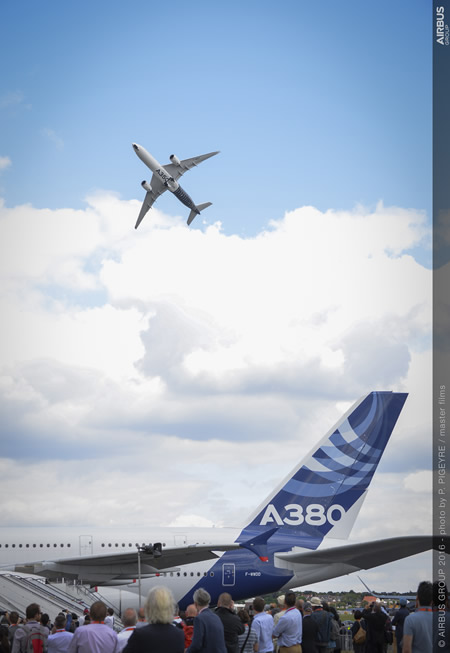
Photo: Airbus’ widebody A350 XWB and A380 were among the commercial jetliners on display - flying and static - during the Farnborough International Airshow. Image provided by & Copyright © AIRBUS GROUP 2016 - photo by P. PIGEYRE / master films.
Five student teams from Australia, China, France, Nigeria and the United Kingdom will compete in the final round of the fifth edition of Airbus’ Fly Your Ideas global challenge, organised in partnership with UNESCO. The radical concepts selected cover a wide range of innovations going from an alternative to satellite imagery, to improved aircraft taxiing, clever ways of boarding, new areas for luggage storage or offering a new business model using existing Airbus aircraft.
Representing different nationalities and universities across Africa, Europe and Asia-Pacific, the five finalist teams embody true diversity, which is a key driver of innovation and performance. The students, competing for a €30,000 prize, also demonstrate a wide variety of disciplines from Natural Sciences to Engineering and Business.
Their inventive ideas, which were selected from over 350 entries, had to answer one of five challenges identified by Airbus to provide sustainable future solutions. The innovations proposed by the five finalist teams look at alternative business models, passengers’ experience and flight operations.
The five finalist teams will soon travel to Toulouse, France, where they will spend a week at the Airbus ProtoSpace facility to prototype, test and visualise their ideas using state-of-the-art equipment with personal guidance from Airbus. At the end of their week at Airbus, the students will present their innovative projects and the newly developed prototype in front of Airbus and UNESCO experts and personalities from the aerospace and academic world. The competition offers a unique opportunity for students worldwide, working in diverse teams of 3-5 members, to develop valuable skills, including teamwork, project management, communications and presentation, and to get involved in engineering.
The ideas competing for the final prize are:
• Airborne Earth Observation - Team SkyVision
University of Surrey, UK
A radical concept that turns a commercial airliner into an ‘Earth Observation Device’ by installing equipment into the belly of the aircraft to monitor ground activity during flight. An alternative to satellite imagery, it opens up new opportunities such as ecology analysis and urban planning.
• Improving Airport Taxi Flow and Efficiency - Team Nevada
Obafemi Awolowo University, Nigeria
An airport taxiing system that uses sensors and algorithms for automated Ground Traffic Control, both in the tower and on the aircraft, to significantly improve aircraft traffic at airports and thus reduce emissions.
• Compact Luggage Strategy Mobile App - Team PassEx
Institut d’Administration des Entreprises - IAE Toulouse, France
A revolutionary boarding system that uses a real-time mobile app to assign boarding status to passengers according to their luggage size. The Compact Luggage Strategy (CLS) addresses current storage issues in over-head compartments by distributing passengers across the aircraft according to the size of their baggage.
• Private Stowage Compartment - Team DAELead
University of Hong Kong, China
A clever aircraft cabin design that locates a Private Stowage Compartment (PSC) underneath passengers’ feet, utilizing the space between the cabin floor and the cargo ceiling.
• A400M Aerial Firefighting Platform - Team Aquarius
Royal Melbourne Institute of Technology, Australia
A fire-fighting solution that incorporates modular systems using pressurized fire retardant containers fixed to fast-loadable pallets for a network of Airbus A400M aircraft, to create a system of aerial firefighting platforms that can be used for rapid wildfire suppression.
|GlobalGiants.Com|
AIRBUS Fly Your Ideas. Previous Online Coverage by “Global Giants” (December 22, 2016)
Edited & Posted by the Editor | 11:13 AM | View the original post
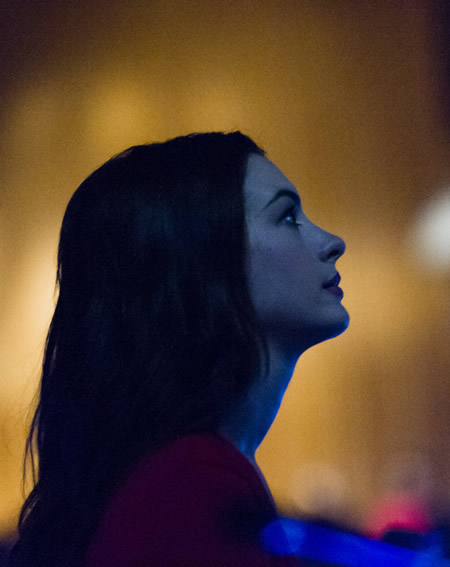
Photo: Observance of International Women’s Day at UN headquarters in New York under the theme “Women in the Changing World of Work: Planet 50-50 by 2030”.
Anne Hathaway, UN Women Global Goodwill Ambassador, watches a video introducing her prior to addressing the event.
08 March 2017. United Nations, New York. UN Photo/Rick Bajornas.
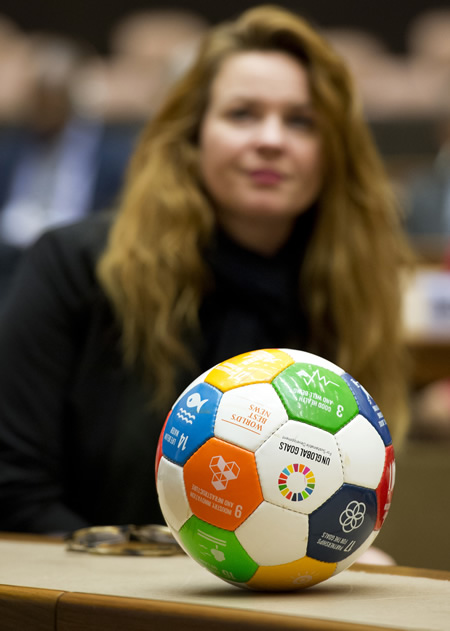
Photo: The UN Office at Geneva (UNOG) holds a series of events, including a roundtable on gender and sport, to mark International Women’s Day (8 March 2017). 08 March 2017. Geneva, Switzerland. UN Photo/Jean-Marc Ferre.
|GlobalGiants.Com|
Edited & Posted by the Editor | 12:58 PM | View the original post

Photo: A Section of Hawa Mahal (Palace of Winds), Jaipur, India. Jaipur was designated a UNESCO Creative City in 2015. Image Credit: David Hamill.
Created in 2004, the UNESCO Creative Cities Network (UCCN) fosters international cooperation with and between cities that have identified creativity as a strategic driver and enabler for sustainable urban regeneration and development.
Today the Network brings together 116 cities from 54 countries, working towards common objectives: placing creativity and cultural industries at the core of local development plans, and actively cooperating through inter-city partnerships at the international level.
The UCCN is a flagship programme of UNESCO for the implementation of the Sustainable Development Goals (SDGs) of the 2030 Agenda, and the New Urban Agenda, at the local level.
UNESCO has invited cities worldwide, who are interested in joining the Network, to submit their applications using the official 2017 Application Form. Applications must be received by UNESCO Secretariat no later than 16 June 2017, midnight CET. Applications received after this deadline will not be evaluated.
Following the evaluation process carried out by internal and external consultations with independent experts and the member cities of the Network, the Director-General of UNESCO would designate the new UNESCO Creative Cities and the announcement of the Creative Cities designated in 2017 will be published on the UNESCO website on 31 October 2017.
|GlobalGiants.Com|
Edited & Posted by the Editor | 9:03 AM | View the original post
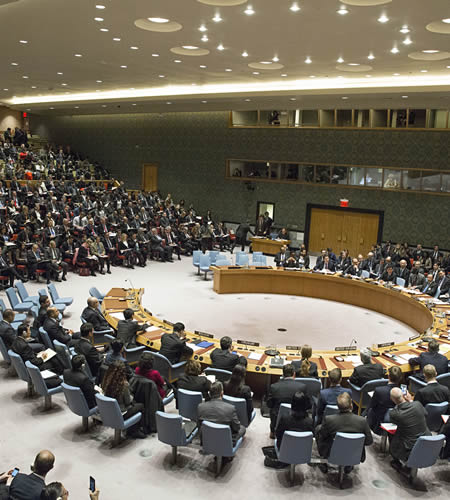
Photo: A view of the Security Council ministerial-level open debate on conflict prevention and sustaining peace. 10 January 2017. United Nations, New York. UN Photo/Evan Schneider.
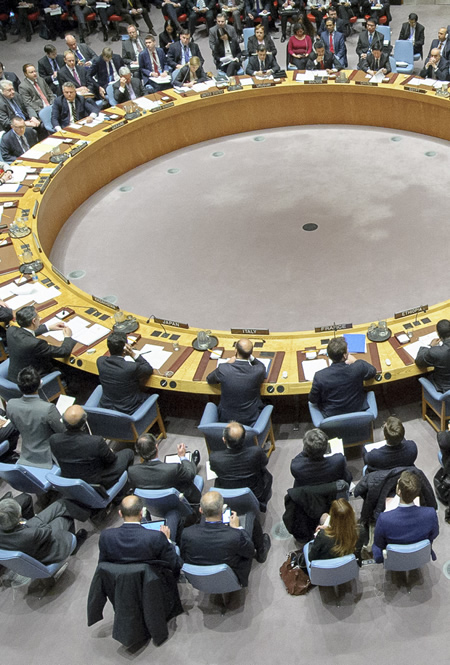
Photo: A view of the UN Security Council ministerial-level open debate on conflict prevention and sustaining peace. 10 January 2017. United Nations, New York. UN Photo/Manuel Elias.
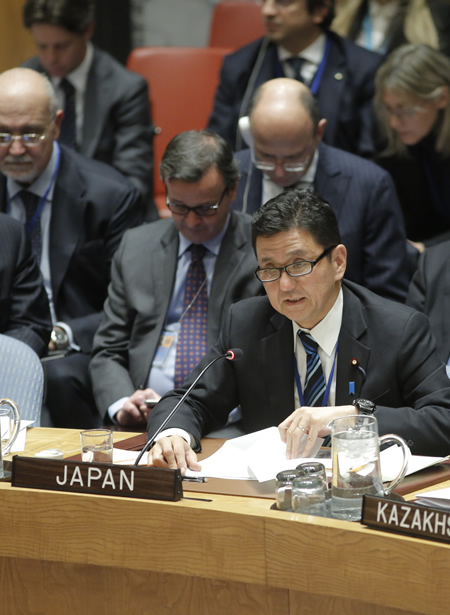
Photo: Nobuo Kishi, State Minister for Foreign Affairs of Japan, addresses the UN Security Council ministerial-level open debate on conflict prevention and sustaining peace. 10 January 2017. United Nations, New York. UN Photo/Evan Schneider.
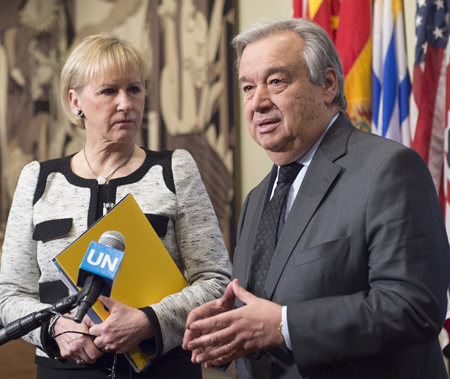
Photo: UN Secretary-General Antonio Guterres (right) addresses journalists with Margot Wallstrom, Minister for Foreign Affairs of Sweden and President of the Security Council for January, on the Council’s open debate on conflict prevention and sustaining peace. 10 January 2017. United Nations, New York. UN Photo/Eskinder Debebe.
|GlobalGiants.Com|

“If they want peace, nations should avoid the pin-pricks that precede cannon shots.”
— Napoleon Bonaparte.

“You do not get peace by shouting: Peace. Peace is a meaningless word; what we need is a glorious peace.”
—Napoleon Bonaparte.
Edited & Posted by the Editor | 11:42 PM | View the original post
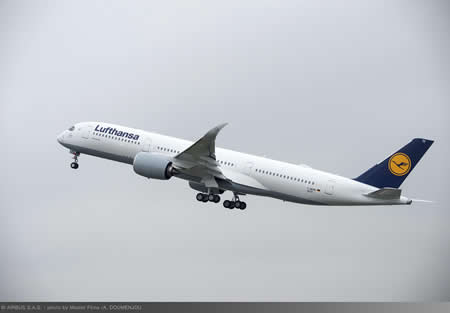
Photo: The first A350-900 for Lufthansa, which performed its maiden flight in November 2016, is part of a 25-aircraft order placed by the German flag carrier. Image provided by & copyright © AIRBUS.
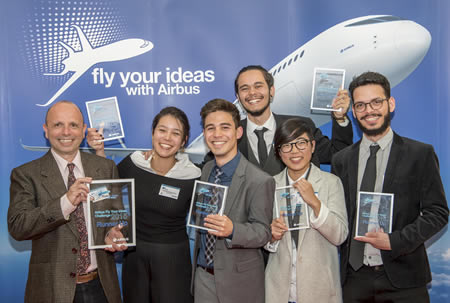
Photo: Team Retrolley from University of Sao Paulo, Brazil, Runners-up of Airbus Fly Your Ideas 2015. From left: Fausto Mascia, Academic mentor University of Sao Paulo, Denise Ikuno, Lucas Otsuka, Tadeu Omae, Maki Shintate, Lucas Neumann. Image provided by & copyright © AIRBUS.
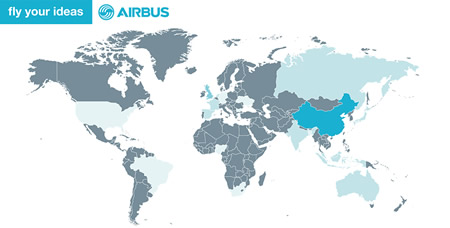
TOULOUSE, France, Dec. 20, 2016 — A record 5,499 students from around the world registered to participate in the fifth edition of Airbus’ Fly Your Ideas, the global student challenge organised in partnership with UNESCO.
A group of 60 Airbus experts and innovators assessed the ideas submitted by 356 teams from 89 countries. The rigorous evaluation process took place at four different Airbus locations in France, Germany, Spain and the UK, with 50 student teams selected to reach Round Two of the competition, starting in January 2017.
The competition is led by teams registered in the Asia-Pacific region. The 50 teams comprise 202 students representing 38 different nationalities. With 52% of teams mixing male and female students, two thirds of all teams are diverse in some way, for example with members coming from different countries or studying different subjects.
Innovative ideas from the 50 chosen teams include robotic luggage trolleys, passenger seats which can be boarded outside the aircraft, new solutions for energy harvesting and virtual reality applications.
“Fly Your Ideas is unique and we are proud of the company-wide engagement of Airbus employees who support the competition, either as assessors, mentors or experts”, says Charles Champion, Airbus Executive Vice President Engineering. “We are offering students the rare opportunity to interact directly with senior specialists from across the business. In turn, these experts will benefit from their direct interaction with talents from across the globe, all sharing the same passion for one of the world’s most exciting industries.”
Each of the teams has 100 days to refine and develop their ideas. The top five teams to make it through to Round Three will spend a week at the “ProtoSpace” based at the Airbus HQ in Toulouse to prototype, test and visualise their ideas using state-of-the art equipment with personalised guidance from Airbus. The winning team will receive a €30,000 prize and the runner up team will receive €15,000 at a live prize giving event in May 2017.
Key figures Fly Your Ideas 2017:
• Number of ideas submitted: 356
• Number of ideas chosen: 50
|GlobalGiants.Com|
#Airbus and #UNESCO: The Fly Your Ideas Partnership. #HigherEd #Universities @Airbus @UNESCO https://t.co/jRaoi9awqu
— GlobalGiants.Com (@GlobalGiants) December 23, 2016
Watch as the #A350-1000 performs its maiden flight - Thanks to all who joined us yesterday for this industry milestone! #A350FF pic.twitter.com/nQZrxqRT6l
— Airbus (@Airbus) November 25, 2016
Edited & Posted by the Editor | 4:33 AM | View the original post
 |
 |
